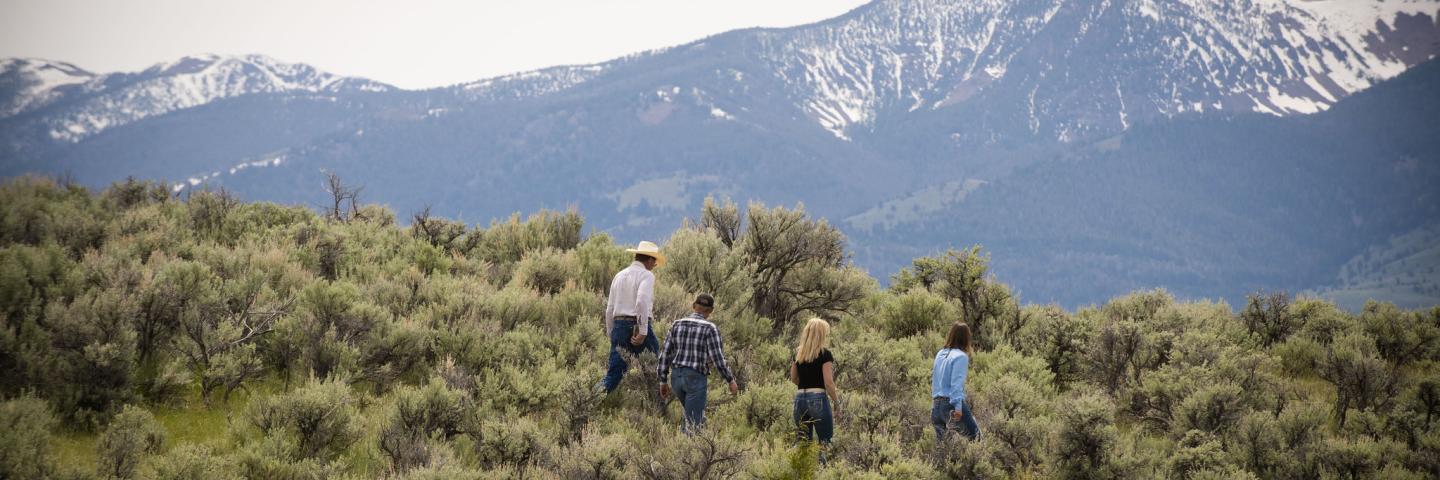Partnering for Easement Success to Benefit Sage Grouse

The USDA Natural Resources Conservation Service (NRCS) in Montana and its conservation partners deliver conservation easements that give peace of mind and a financial boost to ranchers.
Partnering for Easement Success to Benefit Sage Grouse
The USDA Natural Resources Conservation Service (NRCS) in Montana and its conservation partners have joined forces to deliver conservation easements that give peace of mind and a financial boost to ranchers who want to pass on a legacy of big open country that’s vital to a thriving livestock industry in the West, and to the future of sage grouse.
What are conservation easements?
A conservation easement is a voluntary legal agreement between a landowner and a qualified organization, like a land trust, that compensates landowners for placing some restrictions on the use of a property to protect its natural value.
Threats Strategically Addressed Through Easements
Sodbusting
In the northeast part of sage grouse range, 70 percent of the best habitat is privately owned, and the greatest threat is cultivation of native sagebrush rangelands. One landowner converting a single square mile into new cropland negatively impacts sage-grouse in a landscape twelve times that size (Smith et al. 2015). Easements compensate landowners for maintaining the healthy, diverse native plant systems that sage grouse rely on, while continuing to provide grazing resources for livestock.
Recent studies in southern Saskatchewan and northern Montana revealed unknown long-distance dispersal and migration movements in sage grouse that offer fresh insights for conservation. These findings underscore the need to conserve intact sagebrush habitats across large landscapes on both public and private lands to sustain sage grouse movement pathways, their populations, and genetic diversity. Sage Grouse Need Intact Landscapes.
Exurban Development
The expansion of dispersed residential home sites results in habitat loss and fragmentation. Sage grouse need large, intact landscapes and easements keep subdivisions out and maintains the wide-open landscapes the birds need to survive.
Benefits Beyond Grouse
Sage grouse are considered an umbrella species and conservation easements that target sage grouse may benefit more than 350 other species. By conserving the large landscapes that sage grouse need, many kinds of birds and animals also stand to benefit – from pygmy rabbits and sage sparrows to mule deer, elk and pronghorn.
Partners in Conservation Easements
The recent success of the Agricultural Conservation Easement Program (ACEP) in Montana would not be possible without the incredible partners that are dedicated to putting conservation on the ground by pooling resources. This partnership-based, science-driven effort has resulted in more than 130,000 acres of sage grouse habitat permanently protected in Montana since 2015.
The Nature Conservancy
The Nature Conservancy (TNC) in Montana has been working for years with partners, both public and private, to conserve sage grouse and its habitat. Besides partnering with NRCS and landowners on conservation easements, TNC teams with ranchers to improve rangeland health and provides science and research to better target conservation. TNC has worked for years with a single landowner in Valley County, Montana, to purchase conservation easements on more than 25,000 acres by partnering with the NRCS. The conserved land links public and private land in a 23-mile-long corridor of uninterrupted, conserved prairie habitat that is right in the heart of the longest known sage grouse migratory path.
Montana Fish, Wildlife and Parks
Montana is home to roughly 18 percent of the range-wide sage grouse population and Montana Fish, Wildlife and Parks (FWP) is tasked with managing populations through monitoring, mapping priority habitats, and regulating hunting seasons. FWP also provides technical and financial assistance to private landowners wanting to conserve rangelands and sage grouse habitat. An example of this is a conservation easement in the Roy, Montana, area that FWP purchased in conjunction with the NRCS ACEP-Agricultural Land Easements program. The 2,600+ acre easement consists of big sagebrush steppe, mixed grass prairie, and woodland steppe.
Montana Land Reliance
With a mission of partnering with private landowners to permanently protect agricultural lands, fish and wildlife habitat, and open space, the Montana Land Reliance (MLR) has been a key partner in the recent success of NRCS easement programs in sage grouse habitat. MLR and the NRCS recently partnered with a third-generation rancher in Musselshell County to protect more than 11,000 acres of key sage grouse habitat. This easement protects sage grouse habitat while keeping the landowners’ ranch intact and operational while allowing the next generation to continue ranching.
Montana Sage Grouse Habitat Conservation Program
The Montana Sage Grouse Habitat Conservation Program and the Montana Sage Grouse Oversight Team were created to facilitate implementation of Executive Orders 12-2015 and 21-2015, including the Sage Grouse Stewardship Fund. The purpose of the Stewardship Fund is to maintain, enhance, restore, expand or benefit sage grouse habitat and populations through competitive grants. In 2018, TNC and MLR secured funds from the NRCS and the Montana Sage Grouse Habitat Conservation Program to purchase conservation easements.
Building Capacity Through Partnerships
Partners such as the Montana Association of Land Trusts and Ducks Unlimited (DU) are working with the NRCS to provide capacity that is critical to a successful easement program. Increased capacity has resulted in more efficient and effective delivery of conservation to both landowners and partners.
Working in close partnership with agricultural producers and conservation partners, we are conserving habitat for sage grouse while maintaining productive working landscapes.

